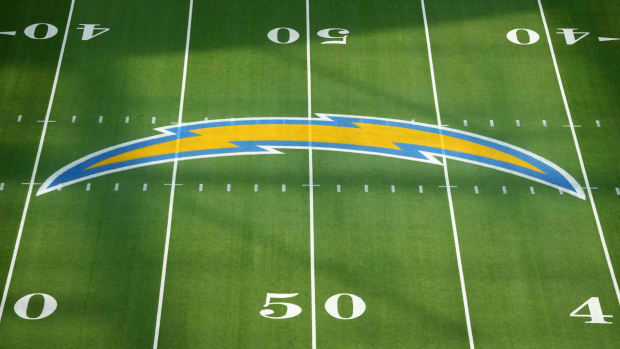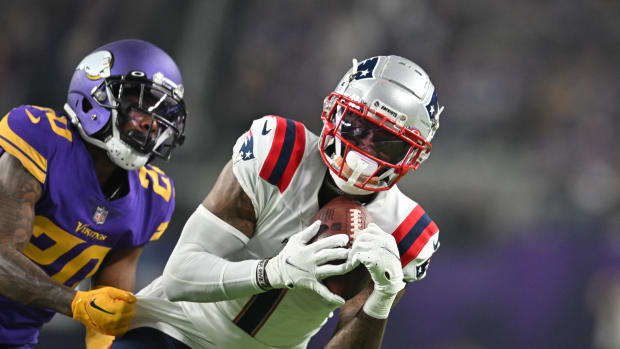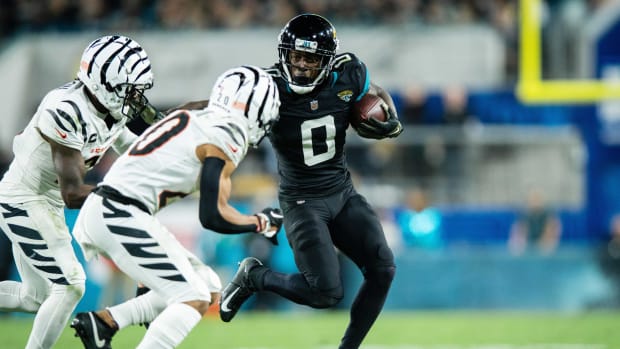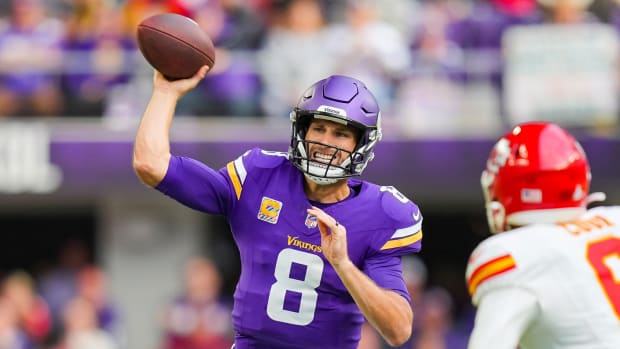
The Revolution Will be Impossible to Defend
Seahawks wideout Percy Harvin will be one of the most valuable players in the NFL this season. The revolution we expected the ex-Viking to bring to Seattle is finally here. A key facet of offensive coordinator Darrell Bevell’s brilliant game plan against the Packers last Thursday was using Harvin on jet sweeps, which usually derived with him being the inside slot on a three-receiver side and then attacking the weak side of the field.
Harvin showed jet-sweep action on seven of his 39 snaps, carrying the ball three times for 13, 9 and 16 yards. In the fourth quarter his jet sweep served as a decoy on both Marshawn Lynch’s 14-yard screen and a six-yard run that helped ice the game.
Harvin won’t actually win the MVP award, because, well, no wide receiver ever has (not even Jerry Rice). More pointedly, Harvin won’t get enough touches to produce MVP numbers. The Seahawks use a wide breadth of substitution patterns. Against Green Bay, those patterns had Harvin going to the bench after any play that had him touching the ball. Don’t be surprised if this remains the case throughout the season; it’s a great way to keep the 5’ 11”, 185-pounder healthy and fresh. But when Harvin is on the field, his jet sweep (and similar motion concepts) will be what defenses fear most.
Harvin, of course, is not the NFL’s only laterally explosive receiver. There’s also Minnesota’s Cordarrelle Patterson, Green Bay’s Randall Cobb, St. Louis’s Tavon Austin and Tennessee’s Dexter McCluster. (There are also several running backs who can also play receiver, such as Detroit’s Reggie Bush, New England’s Shane Vereen and Philadelphia’s Darren Sproles.) But aside from McCluster being paired with Jake Locker, Harvin is the only one who plays with a truly mobile quarterback. And Bevell has built jet sweeps into Seattle’s existing read-option package, adding a third threat to a scenario that already had defenses dealing with Russell Wilson and Marshawn Lynch. The Packers had severe problems defending this.
Jet sweeps aren’t the only way Seattle will feature Harvin. They’ll throw him swing passes and also bring him out of the backfield. And when Harvin does simply line up and run a standard route, there’s a good chance he’ll do so against an overmatched defender. On his first catch in Week 1, he was in a “tight split,” aligned close to the offensive line. With the Packers in zone coverage, this left him facing linebacker Brad Jones, which is a laughable matchup that Jones will only ever win if Harvin slips and falls. He went for 33 yards. On Harvin’s second catch (a nine-yarder) he was aligned in the weak-side slot in a 3 x 2 empty set, which meant safety Morgan Burnett had to guard him. Linebackers and safeties can’t cover one of the quickest and most explosive receivers in football. The more matchups like this the Seahawks create for Harvin, the more havoc he’ll wreak.
Jumping out on film
Matt Ryan (Kevin C. Cox/Getty Images)
Maybe quarterbacks “jump out on film” by default, so maybe it shouldn’t be so surprising that Matt Ryan jumped out in Atlanta’s 37-34 overtime win over New Orleans. I mean, how else do you describe 448 yards, three touchdowns and zero interceptions? But it’s still worth highlighting, because those yards and touchdowns came in two ways that are of atypical of Ryan’s skill set: out of a collapsing pocket and on the move. Ryan, while not statuesque, is mostly a prototypical pocket passer. And because he doesn’t have a cannon-like arm, he often needs functional space in order to step into his throws. This is why the Falcons used their first-round pick on left tackle Jake Matthews (who, by the way, showed veritable Pro Bowl potential before injuring his ankle midway through the game. But in Week 1, Ryan mustered uncommon arm strength to make several big-time throws under less than ideal circumstances—the highlight being his 21-yarder down the seam to Devin Hester that exploited the Cover 2 zone the Saints had played for most of the game. That set up the game-tying field goal at the end of regulation. With his receivers healthy, Ryan will have opportunities for more outstanding showings this season. He’s set a new bar for himself.
Smart watching for Week 2
On the perimeter, the Bears will go heavy and hard through the air during Sunday night’s game in San Francisco. A major element of Marc Trestman’s passing game is the “switch release”—when two wide receivers who are aligned on the same side crisscross early in their routes. Conceptually, this is a great way to defeat man coverage on shorter patterns. But it can also be a zone-beater for deeper routes, which is how Trestman generally employs it. He couldn’t ask for a better downfield combo than Brandon Marshall and Alshon Jeffery. You’ll see these two frequently align tight to the formation alongside one another, maximizing the amount of field both have to work with. The Niners are thin at cornerback and their best playmaker, safety Eric Reid, patrols the middle of the field. Switch releases will propagate deep shots to the outside, away from Reid. The only concern is that they can take a little longer to execute, putting stress on the offensive line. But the Bears’ O-line was sharp in Week 1 against the Bills, while the Niners’ pass rush, despite sacking Tony Romo three times, was too often a nonfactor against Dallas. That may not change until Aldon Smith returns from suspension.
Bears receivers Brandon Marshall and Alshon Jeffery against the Bills. (David E. Klutho/Sports Illustrated/The MMQB)
Impressive Coaching
We know what the Cardinals will be doing on defense this season, and it looks a lot like what they did last year. Late in their tightly contested Monday night tilt against the Chargers, head coach Bruce Arians and defensive coordinator Todd Bowles ratcheted up the pressure and got even more aggressive with the A-gap blitz attacks that they had been featuring all game. Talk about trusting your man-to-man defenders. This is what the Cardinals pay for, though. This offseason they signed Patrick Peterson to a megadeal and brought in free agent Antonio Cromartie. Both are superb solo man cover artists (and just mediocre zone defenders). That’s the type of secondary you need in order to blitz like crazy.
What was really impressive is the way Arizona’s linebackers, particularly Larry Foote (who deserves Defensive Player of the Week consideration), attacked San Diego’s running backs in man coverage. Instead of waiting to pick them up downfield, they immediately went after the backs. The effect was two-fold: it disrupted the underneath passing game that Philip Rivers relies so heavily on, and it automatically made those linebackers full-speed blitzers whenever the running backs stayed in and blocked. The Giants, who looked horrible offensively against the Lions, host the Cardinals this week. Eli Manning and his receivers must rectify the confusion with their presnap hand signals because their opponent will be bringing the house.
10 Quick-Hit Thoughts From Film Study
1) All three of Tony Romo’s interceptions were bad reads coming on first down off of play-action. Last year, Romo didn’t throw a single interception off play-action.
2) The Dolphins took away the Patriots’ short passing game by rushing only three and dropping a defensive lineman into shallow coverage. That’s the same thing Seattle did to Denver in last season’s Super Bowl.
3) The Dolphins defense didn’t win only in the short passing game. According to ESPN Stats & Information, Tom Brady was just 2 of 18 on passes when the ball traveled at least 15 yards from the line of scrimmage. His offensive line was overmatched—something the Patriots seemed to expect coming in, given how many three-step timing throws offensive coordinator Josh McDaniels called early on. You could see Brady becoming less comfortable in the pocket as the game progressed.
4) Jake Locker, though still erratic at times, showed improvements against the Chiefs even though his offensive line, particularly left guard Andy Levitre, struggled to provide adequate pass protection. Ken Whisenhunt and his staff did a good job with formations and personnel groupings to create defined reads for the 26-year-old QB. When Locker knows early in the down where he’s supposed to throw the ball, he’s a much more decisive QB.
5) It doesn’t look like the Bills are going to become a vanilla 4-3 zone defense under new coordinator Jim Schwartz, who was very aggressive and diverse with his sub-package fronts and pressure concepts against Chicago.
Reggie Nelson brings down Ravens wideout Steve Smith. (Simon Bruty/SI/The MMQB)
6) On a similar note, the Bengals’ D is still the Bengals’ D, even with coordinator Mike Zimmer now in Minnesota. His longtime understudy, Paul Guenther, was even more aggressive with Cincy’s patented double A-gap pressure packages against Baltimore. Reggie Nelson was practically a fulltime edge blitzer.
7) The most underrated linebacker in football might well be the Saints’ Curtis Lofton. His football IQ has climbed under Rob Ryan; same for his speed and short-area quickness.
8) You don’t need to study film to know that the Colts’ defense will be hurting without Robert Mathis (Achilles). Erik Walden offers no explosiveness and Bjoern Werner remains inexperienced. Chuck Pagano’s key players are now his cornerbacks, who will have to hold up in solo man coverage a pass rush to be manufactured through blitzing.
9) While Bears coach Marc Trestman likes to align his star receivers on the same side of the field, Falcons offensive coordinator Dirk Koetter prefers to balance Julio Jones opposite Roddy White. That helps set up man-beater patterns on one side and zone-beaters on the other.
10) The Ravens’ offense was out of synch on Sunday, but the O-line wasn’t. For the most part, it held up well with Gary Kubiak calling 67 pass plays against Cincinnati, many of them out of empty sets that left the men up front with no help.













































